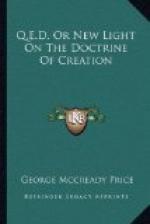We need not be particularly concerned here with the theoretical explanations of these facts offered in terms of the microscopic or even the infra-microscopic components of the germ cells. Morgan seems to make out a strong case for the theory that the chromosomes found in the nucleus are the real ultimate units that carry the hereditary factors. But he is quite decided in the opinion that these hereditary factors are fixed, and are not changed from generation to generation either by environment or by selection.[27] The important thing for us in this connection is to get a clear idea of the results following from an application of Mendel’s laws to the old, old problem of the origin of species, incidentally noticing how the theory associated with Darwin’s name now looks in the light of these new facts.
[Footnote 27: In human beings it has been found that the effects of alcoholism and of syphilis are indeed transmitted according to Mendelian law, being the two solitary examples of diseased conditions that are thus transmitted. But they are so plainly pathologic phenomena that there is little temptation for the advocates of Lamarckianism to use them as proofs of their theory.]
We have hitherto been considering the results worked out by Mendel with but one pair of contrasted characters or factors. But Mendel studied the relation of other characters of the pea, and found among other results that smooth seeds are dominant to wrinkled seeds, colored seeds dominant to white, yellow color dominant to green, etc. But when a combination of two factors in each parent are put into contrast by cross breeding, two wholly original forms (as they seemed) were sometimes produced, and it looked as if these new kinds were really analogous to new species.
For example, he crossed tall yellow peas with dwarf green peas, with the result that the first hybrid generation turned out to be all tall yellows. However, in the second hybrid generation they split up according to the law as already stated, modified by the additional complication brought into the problem by the additional pair of factors. For out of every sixteen plants there were nine tall yellows, three dwarf yellows, three tall greens, and one dwarf green. It is evident that these tall greens and dwarf yellows are really new forms; and further experiments proved that they can be separated out or segregated and grown as pure forms which thereafter breed true. Thus we have a very important result for the breeder, for it enables him to work to a definite aim and combine certain desirable characters into a single form.




